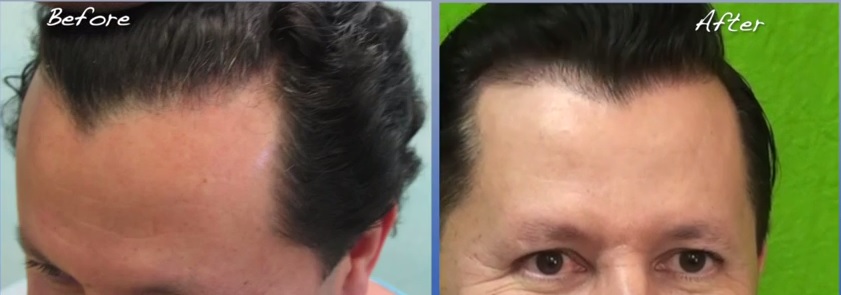But the hairline is also much more than that. It is the essential wall of hair that gives balance to a unique countenance, acting as a frame for the face. Without it, the facial-skeletal ratios are thrown askew. The forehead becomes disproportionately large, leaving the hair loss sufferer in a cosmetic quandary. A dilemma so disturbing it commonly leads to depression, social withdrawal, and even professional impediment. Thus, the hairline is an invaluable detail.

HAIR LOSS
The majority of hair loss in both men and women is the manifestation of pattern baldness, or androgenic alopecia. Carried down the afflicted family lineage as weak androgen receptors residing in the X chromosomes, the genetic influence causes scalp hair to be particularly sensitive to DHT/dihydrotestosterone. Certain follicles are, in fact, so sensitive that this ordinary hormone destroys the hair and, in the long run, produces baldness.
Hairline recession is specific to men and specific to pattern baldness. However, another common source of hairline loss is traction alopecia. Traction alopecia is especially prevalent in African American women.

Hairline Reconstruction
In men, hair restoration typically revolves around restoring hair to the crown and hairline. But there are several critical factors for the surgeon to take into account when rebuilding either area. The hairline requires awareness of the following considerations:
- Hairline position
- Hairline shape
- Hairline density
- Hairline texture
Hairline Reconstruction : Position
The positioning of the hairline is what will restore the facial balance, so the surgeon must find the line carefully. A guiding tool like the Rule of Thirds is a helpful starting point, but the surgeon must ultimately rely on his/her artistic vision to be able to properly place the hairline in each unique case. Positioning also takes into account the temporal recesses, without which it would be impossible to build a natural-looking hairline. Where the hairline flows into the temple points, each hair subtly changing angle and direction, the graft placement must be smooth and seamless.

Hairline Reconstruction : Shape
Hairline shape is another artistic creation that nature tailored specifically to each person’s unique facial contours. The procedure must mimic nature in this regard, creating, for example, a symmetrical result.

Hairline Reconstruction : Density
Density includes the spacing of hair at the hairline as well as the pattern of placement. For instance, the hairs may be placed very close together for extreme density (which will require more grafts for complete coverage) or a little bit farther apart for modest density; they can be placed in an aggressive straight line or a subtle zigzag. Also, if the surgeon chooses a hairline position favoring closer proximity to the eyebrows, the hairline should, by nature, be slightly denser. And likewise visa-versa—although this is not a concrete rule and must still be carefully tailored.
Hairline Reconstruction : Texture
The texture of the hair accounts for thickness, coarseness, and curvature. Traditional hair transplant harvests hair from the mid-occipital scalp—where hair also happens to have the thickest texture. These grafts tend to proffer harsh, unnatural-looking results. Advanced transplant techniques use hair from the nape of the neck, or even leg hairs, (only possible with FUE) due to their finer character.
Ethnicity is also a textural consideration. As African Americans tend to have curled hair follicles, so Asians tend to have very thick hair follicles, with less actual hair per square centimeter of scalp. These follicles would make the hairline appear harsh, so for Asian patients in particular, the surgeon should use nape or leg hairs.

Hairline Reconstruction : PHOTOS AND VIDEOS
Rely on photos and videos as evidence of the best surgeons and the best treatment available. Seeing the before-and-afters of people who have gone before you gives you an opportunity to examine the positioning, shape, density, and texture of hairs used—the graft selection and placement that will decide your future results. A photo or a video of a hairline transplant procedure should be in clear focus and good light, and show the patient from the front and sides of the head. Be careful not to trust any images that have been photo-shopped or edited to enhance the appearance.

FAQ
What exactly is traction alopecia?
Traction alopecia is defined by hair loss along the anterior and posterior hairlines from a constant pulling force on the hair. This is normally caused by tight hairstyles like braids, weaves, cornrows, and extensions worn frequently or daily. Over time, this pulling damages the scalp, resulting in diffuse scarring and permanent hair loss.
What are some other causes of hair loss not specific to the hairline?
Some other causes of hair loss include malnourishment, severe stress, pregnancy, hormonal changes, thyroid dysfunction, diabetes, lupus, and trichotillomania. Most of these would not necessitate hairline reconstruction.
Here is another patient video which involves a reconstruction of the hairline and crown area. 10,000 grafts were used to produce his result. Click here to read more and watch his video.
Read Dr U’s article on natural hairline creation using nape hairs in the ASJ

